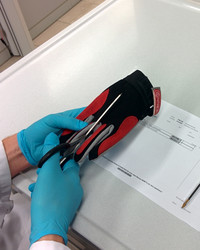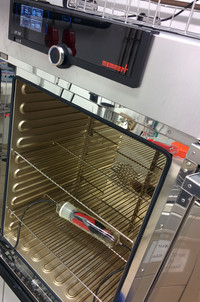KANBrief 3/15


Polyurethane-coated protective gloves may contain manufacturing residues of N,N-dimethylformamide (DMF) (See KANBrief 1/2014). This substance is classified as a reprotoxin, and chronic exposure to it can also damage the liver. In order for unnecessary exposure to DMF to be avoided, protective gloves must contain no more than 10 mg of DMF per kilogramme of glove material. Monitoring of this preventive healthcare measure requires a sensitive analytical method.
The quantitative analysis of DMF in work gloves presents a number of different analytical problems. Firstly, DMF is a volatile substance and may therefore be lost even whilst the sample is being prepared. Work gloves may also be contaminated unevenly. A representative material sample is therefore important.
Development of a new, highly sensitive method for determining the DMF content
The test method specified in prEN 16778, Protective gloves – The determination of Dimethylformamide in gloves, is based upon solvent extraction and employs methanol as the solvent. Owing to its toxicity however, this method should be avoided from an OSH perspective. Furthermore, the sensitivity of the method is constrained by the quantity of solvent employed. In the course of a research project funded by the DGUV, the Fraunhofer Wilhelm Klauditz Institute (WKI) therefore examined whether a thermal extraction method would be suitable for determining the DMF content.
The thermal treatment of work gloves was found to be well suited to releasing DMF from the material. However, excessively high temperatures must be avoided in order to prevent decomposition of the glove material. For this reason, the study focussed upon specification and optimization of the extraction conditions. A new test method should also be based upon established and commercially available methods and equipment, so as not to limit the number of possible test laboratories able to perform it.
Thermal extraction for determining of the content
The study showed that the combination of thermal extraction and thermal desorption yielded high sensitivity to DMF and permitted quantitative analysis of the substance in the selected gloves. During thermal extraction, the sample is washed by a defined gas stream in an oven. The target substance is precipitated from the gas phase onto a suitable material. Subsequent thermal desorption then releases the substance, which is quantified by means of gas chromatography coupled with mass spectrometry (GC/MS). This combination permits flexible dilution of the sample air whilst at the same time enabling the substance under analysis to be accumulated without the use of solvents. Dilution is of considerable importance for this analysis method, since other substances that could influence analysis were seen to be released in large quantities during heating of the gloves.
Essential results of the project
Despite the need for dilution, the thermal extraction method is extremely sensitive and enables DMF concentrations of < 1 mg/kg to be determined in work gloves. However, the method exhibits the same fundamental problem as the methanol extraction method: the standard thermal extraction apparatus is unable to cover the entire glove, and a sample of the material must therefore be cut. To permit evaluation of the effects of possible sample cuts, a system was developed as part of the research project with which entire gloves can be analysed. Whereas the influence of the selected cut is negligible in the case of homogeneous materials, samples from gloves known to be manufactured from different materials must be selected such that they contain a representative quantity of the component containing DMF. This aspect constitutes the greatest challenge for description of a suitable test method.
Should the methanol extraction method, currently strongly favoured in standardization and described in prEN 16778, not prove effective in the field, the thermal extraction method would thus constitute an alternative that in fact involves more conventional laboratory procedures. A further important result of the project is that half of the protective gloves studied contained less than 10 mg of DMF per kilogramme of glove material. This shows that this value can be attained and can be regarded as the state of the art.
Dr Tobias Schripp
tobias.schripp@wki.fraunhofer.de